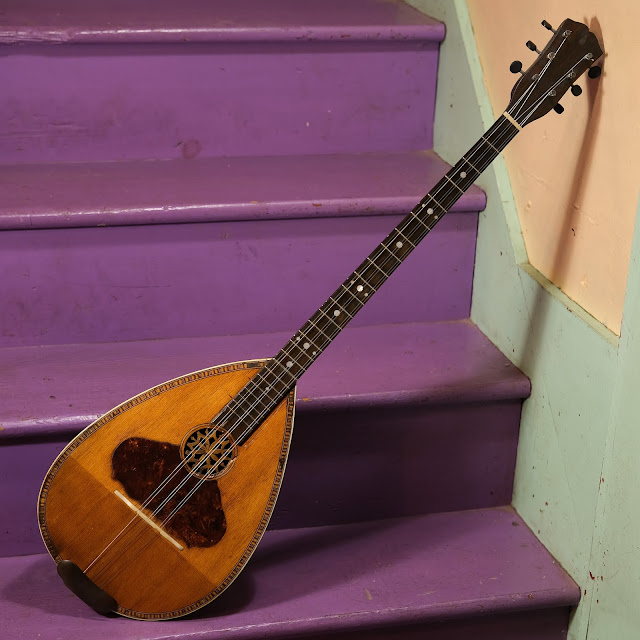1920s Vracas Trichordo Greek Bouzouki
I worked on another New York-made Vracas bouzouki for a customer in 2014. This time around, I'd purchased the instrument myself. I'd gotten a call out of the blue from an antiquer in the midwest about it and figured I needed to save this one from its demise.
I've learned a bit more about these since then and I was pretty sure this instrument would have been strung-up as a "trichordo" (3-course) bouzouki so, post-repairs, that's how I've adjusted it and set it up -- save that I have it a step down from normal DAD pitch to CGC so that I can enjoy the warmth of its sound.
The to-be owner of this bouzouki, however, informed me that bouzoukis of this type and at this period often used a 4-2-2 or 3-2-2 stringing pattern. Well that makes sense! I'd been wondering about why so many old 6-string bouzoukis had 8-string tuners. I don't particularly think the necks are durable enough to really use all 8 strings, but at least some of that mystery is solved. In fact, the mangled remains of the nut on this guy looked like it had the 3-2-2 pattern on it when it came in. The original nut on the other Vracas bouzouki was slotted for 4-2-2 stringing, for what it's worth.
Still, I replaced the slippery original 8-string tuners for repro StewMac 6-string ones so it could be strung-up in the "modern" 6-string fashion. I'm not sure that I would want to be stringing this old gal up much heavier than what's on it -- it's a lightly-built instrument and these necks are long and unreinforced.
After work, this instrument plays perfectly, has a straight neck, and low action. The top is solid spruce while the bowl is contrasting maple and rosewood.
Repairs included: neck reset, top repair, fret level/dress, brace regluing, side dots install, new repro tuners for the headstock, new compensated bridge, new nut, cleaning, setup.
Made by: Vracas
Made in: New York City, NY, USA
Top wood: solid spruce
Back & sides wood: solid maple and rosewood
Bracing type: ladder
Bridge: bone
Fretboard: ebonized maple or similar
Neck wood: mahogany
Tone: sweet, warm, sustained, projecting
Action height at 12th fret: 1/16" overall (fast)
String gauges: 10/26w, 14/14, 10/10 low to high
Neck shape: medium-deep D
Board radius: flat
Neck relief: straight
Fret style: low/small
Scale length: 25"
Nut width: 1 1/8"
Body length: 14 1/4"
Body width: 10"
Body depth: 5 1/2"
Weight: 1 lb 15 oz
Condition notes: the neck's dowel (this has a tenon joint) had been knocked right through the top of the instrument at some point in the past and split the top and the dowel. When I reset the neck I epoxied the dowel's mess all back together and reinforced the very lowest portion of the heel with a long screw/bolt that helps remove a lot of stress from the fractured dowel. Then I glued it up as-normal. The old joint trauma is clearly visible on the top in the missing bits of purfling and the cracks running along the side of the fretboard extension. Everything is sturdy and good to go, however.
More notes: the only other crack is a very short hairline on the lower-bout-top near the tailpiece and it's sealed. The bowl has some wear and tear along its seams but is sturdy and not coming-apart anywhere. The whole instrument looks like it got an extra layer of brushed-on varnish at some point, too. Thankfully, it's over the original finish, so it's not obvious unless you're going over it carefully. The headstock has five patched holes in it with varying degrees of cleanliness. My filler for the tuner-post-hole fills reacted with the topcoat of finish a little bit but at least it's dark so it's not obvious.
















Comments